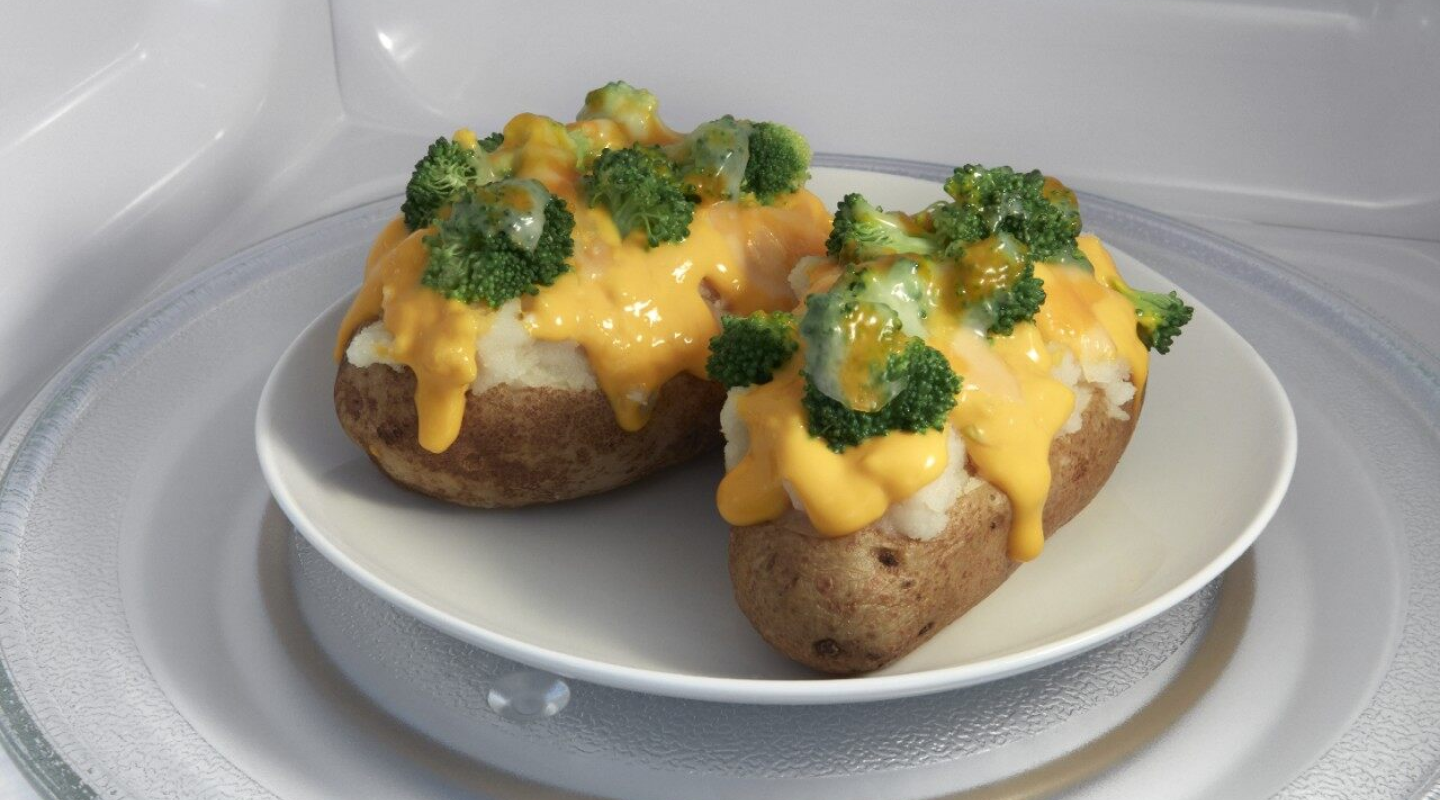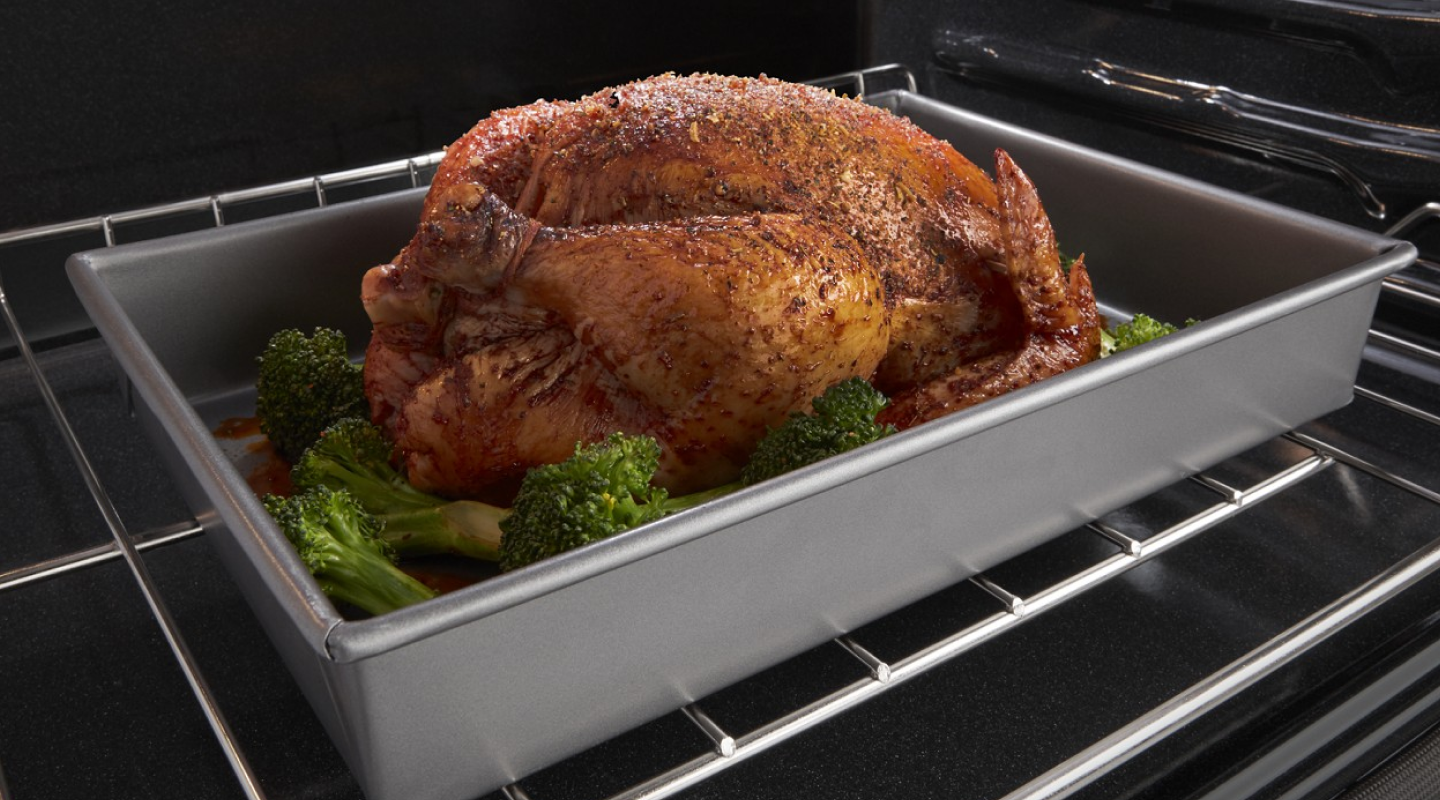
Microwave vs. convection oven: what’s the difference?
When it comes to cooking appliances, microwaves and ovens are widely considered to be kitchen staples that can handle a wide variety of cooking tasks. While both of these appliances have similar uses, they have some key differences that can affect how your meals turn out.
Explore the differences between microwaves and convection ovens, as well as their unique advantages and get a better understanding of which appliance is best suited for your cooking needs.
What’s the difference between a microwave and oven?
Ovens use radiant heat from electric or gas heating elements within the oven cavity to cook food. Microwaves, on the other hand, use electromagnetic waves to rapidly heat food and can be more energy-efficient for cooking or reheating small portions of food. A true convection oven introduces a third heating element and a fan that promotes browning, crisping and faster cooking times than a conventional oven. While ovens offer larger capacities and may provide more versatility for cooking a wider range of dishes, they typically have higher price points than a microwave and may take longer to preheat and cook. Ultimately, the choice between a microwave and an oven depends on your cooking needs and budget.


What is a microwave?
A microwave is a kitchen appliance that uses electromagnetic waves at a high frequency to quickly cook, heat or defrost food. It works by generating microwaves that penetrate the food, causing the water molecules to vibrate and generate heat. Microwaves are time-efficient and convenient for everyday use, as they can cook food in minutes, making them ideal for reheating leftovers, making popcorn or cooking simple meals. Microwaves come in a range of sizes and styles, from countertop models to built-in options, and can offer additional features such as grill or steam functions. Overall, microwaves are a popular and versatile appliance for cooking and heating food quickly and easily.

Find the right wall oven for you

Compare different types of microwaves
What can you cook with a microwave?
A microwave is a versatile kitchen appliance that can quickly and easily cook a variety of foods, from reheating leftovers to steaming vegetables or making popcorn. In addition to these basic functions, some microwaves come with advanced features such as grill and convection cooking settings, which can expand their capabilities even further. With a convection microwave, you can cook not just simple meals like scrambled eggs, baked potatoes and rice, but also pastries, casseroles, crispy chicken breasts, and other baked or roasted foods. Whether you're a busy professional or a home cook looking to save time in the kitchen, a convection microwave can be a convenient and efficient addition to your culinary repertoire.


What are the advantages of cooking with a microwave?
Microwaves have several advantages over traditional cooking methods. They're convenient because they typically offer multiple functions, such as pre-heating, defrosting, boiling, steaming and simmering. They're also easy to use, can cook food faster than even a convection oven and are typically more affordable.
Microwaves also take up less space and can be easier to clean than traditional ovens. In addition, microwaves can be more energy-efficient than convection ovens because they don't need to heat up the entire cooking compartment. Instead, they use electromagnetic waves to heat food directly.

Size
Microwaves come in a variety of sizes to accommodate different kitchen spaces and cooking needs. Compact models are ideal for small apartments or dorm rooms, while larger models can handle larger dishware and family homes. Compact microwave sizes can typically start at 0.5, while larger sizes can go up to 2.2 cubic feet.

Speed of cooking
Microwaves are known for their speed when it comes to cooking food. The cooking speed of a microwave depends on the wattage of the appliance, with higher-wattage microwaves cooking food faster than lower wattage models. Generally, microwaves range from 600 to 1,700 watts, with most home models falling between 1,000 and 1,200 watts.

Price
The average price for purchasing a microwave varies depending on the size and features of the appliance. Compact models can be found for around $50, while larger models with advanced smart features can cost upwards of $500. Most mid-range microwaves fall between $100 and $300.

Method of cooking
Microwaves use a unique method of cooking known as microwave radiation. This radiation excites water molecules in food, causing them to vibrate and heat up, which in turn cooks the food. Some microwaves also offer additional cooking methods, such as convection cooking or air frying and broiling.

Effects on food
Microwaves can be a convenient option for reheating food quickly and effectively, but they can also have an impact on the texture and flavor of certain foods. Overheating or unevenly heating certain foods can cause them to become dry or tough, while some foods may lose their crispness or browning when reheated in a microwave. It's important to follow proper reheating guidelines and use appropriate containers to minimize the effects of microwaving on food. Select Microwaves by Whirlpool brand include features like convection cooking that help crisp up foods and promote browning like an oven. Sensor Cooking tracks the progress of your food and automatically adjusts cook times to help avoid over or under-cooking.


What is a convection oven?
A true convection oven uses a third heating element and a fan to circulate hot air and cook most dishes faster than a conventional oven. It works by blowing hot air over and around the food, which helps to seal in moisture and create a crispy exterior. Convection ovens can be used for baking, roasting and broiling and are available in both electric and gas models.

True Convection with Third Heating Element
Get dinner on the table quickly
True convection cooking helps you cook foods faster by using a third element plus a fan to distribute hot air evenly over, under and around food
What can you cook with a convection oven?
With a convection oven, you can cook a variety of dishes, including meats, vegetables, baked goods and casseroles. The even heat distribution across multiple racks and faster cooking time make it a popular choice for roasting meats or vegetables, baking dense, non-yeasted mixtures like quick breads and getting perfectly browned cheese on pizza. Avoid convection settings for yeasted recipes, liquid mixtures like custard and delicate items like souffles.


What are advantages of cooking with a convection oven?
Convection ovens offer several advantages, including faster and more even cooking across multiple racks. They are also more versatile and can generally be used for a wider range of cooking methods than traditional ovens. Convection ovens can distribute heat evenly across racks, which can result in more evenly cooked and crispier foods.
Additionally, convection ovens are typically larger than microwave ovens and can accommodate larger cooking dishes.

Size
Convection ovens come in various sizes, ranging from small countertop models to larger built-in models that are designed to fit in a standard-sized oven space. The size of the oven you choose will depend on your needs and the amount of cooking space you require.

Speed of cooking
Convection ovens are designed to cook most foods faster than traditional ovens because of the additional heating element and fan that circulates hot air throughout the oven. The speed of cooking can vary depending on the recipe and the type of food being cooked.

Price
The cost of a convection oven may vary based on factors such as the size, brand, types and features. On average, a basic countertop convection oven can cost between $100 and $300, while a full-sized convection oven can range from $500 to $2,000 or more.

Method of cooking
Convection ovens are useful for various cooking methods, including roasting, baking, grilling and toasting. Some models also include settings for dehydrating and air frying. The even heat distribution of a convection oven can help to produce evenly cooked and crispy food across multiple racks.

Effects on food
When reheating food in a convection oven, it is recommended to use a lower temperature setting. Convection ovens can help to produce a crispy exterior while keeping the interior of the food moist.


Can you use a microwave as an oven?
While conventional microwaves can perform some of the same functions as an oven, such as heating, cooking and thawing, it cannot replace a traditional oven completely. Traditional microwaves use electromagnetic waves to cook food, while ovens use heat from heating elements and offer larger capacities. This means that microwaves cannot brown or crisp food in the same way as an oven can. However, some microwaves like these Whirlpool brand models come equipped with convection cooking, which uses a combination of heat and fan-forced air to cook food more like an oven. Convection microwaves allow you to bake, broil and roast in addition to traditional microwave functions.

Whirlpool® Microwaves
A microwave for every home
From countertop options to microwave hood combinations, find the right fit for your family with microwaves from Whirlpool brand
Explore Whirlpool® microwaves and convection ovens
Whirlpool brand offers a range of high-quality microwaves and ovens that can make cooking and baking a breeze. Select Whirlpool brand microwaves come equipped with features like convection cooking and steam cooking, while select ovens offer advanced temperature control and even baking to help upgrade your cooking game.


Helping kids stay in school
Learn how Whirlpool helps end the dropout cycle by giving kids access to clean clothes through the Care Counts™ Laundry Program
Was this article helpful? Pass it on
Explore more from Whirlpool brand
-
 How Do Microwaves Work to Cook Your Food? How do microwave ovens work to cook and heat food? Are microwaves safe? Learn more about this popular kitchen appliance with this guide from Whirlpool.
How Do Microwaves Work to Cook Your Food? How do microwave ovens work to cook and heat food? Are microwaves safe? Learn more about this popular kitchen appliance with this guide from Whirlpool. -
 Conventional Oven vs. Convection: What’s the Difference? Learn the difference between a conventional vs. convection oven. Discover the pros and cons of standard and convection ovens for cooking, baking and roasting.
Conventional Oven vs. Convection: What’s the Difference? Learn the difference between a conventional vs. convection oven. Discover the pros and cons of standard and convection ovens for cooking, baking and roasting. -
 What Is a Convection Microwave Oven? Learn what a convection microwave is and how it works. Discover what you can cook in it and how it can serve as a second oven in your kitchen.
What Is a Convection Microwave Oven? Learn what a convection microwave is and how it works. Discover what you can cook in it and how it can serve as a second oven in your kitchen.


home heartbeat
Ready for more tips, home hacks and appliance guides?

